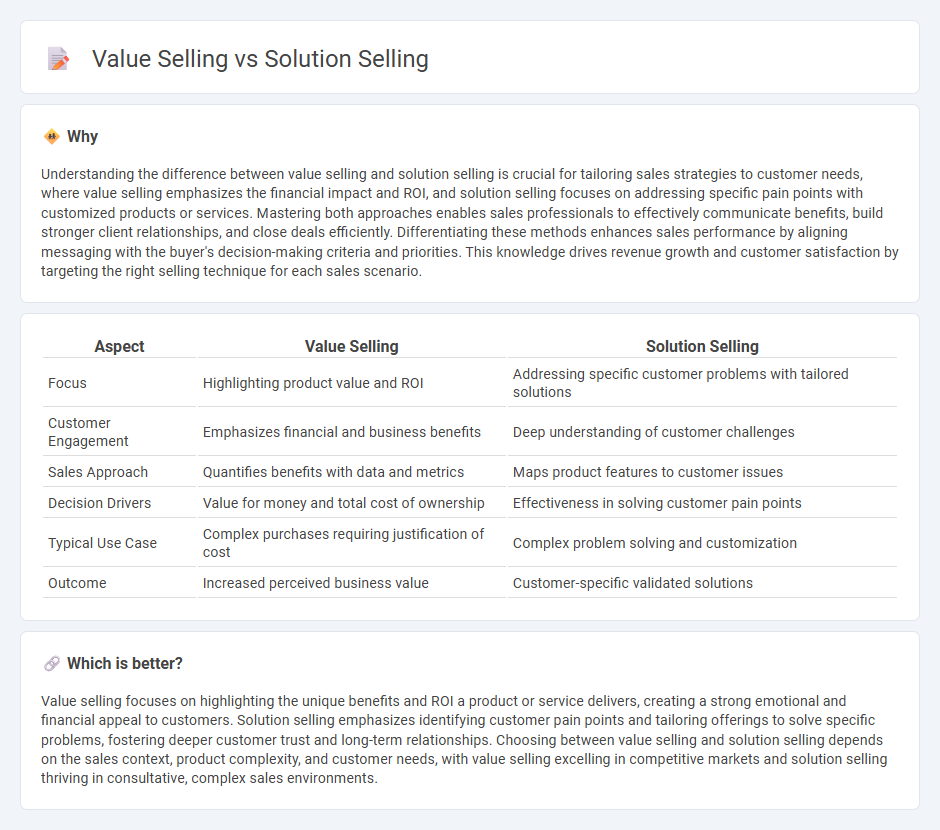
Value selling emphasizes the unique benefits and ROI a product or service delivers to the customer, focusing on how it aligns with their specific business needs and challenges. Solution selling centers on diagnosing the customer's pain points and tailoring a comprehensive product or service package that resolves those issues effectively. Explore the key differences and strategies of both approaches to enhance your sales performance and customer engagement.
Why it is important
Understanding the difference between value selling and solution selling is crucial for tailoring sales strategies to customer needs, where value selling emphasizes the financial impact and ROI, and solution selling focuses on addressing specific pain points with customized products or services. Mastering both approaches enables sales professionals to effectively communicate benefits, build stronger client relationships, and close deals efficiently. Differentiating these methods enhances sales performance by aligning messaging with the buyer's decision-making criteria and priorities. This knowledge drives revenue growth and customer satisfaction by targeting the right selling technique for each sales scenario.
Comparison Table
| Aspect | Value Selling | Solution Selling |
|---|---|---|
| Focus | Highlighting product value and ROI | Addressing specific customer problems with tailored solutions |
| Customer Engagement | Emphasizes financial and business benefits | Deep understanding of customer challenges |
| Sales Approach | Quantifies benefits with data and metrics | Maps product features to customer issues |
| Decision Drivers | Value for money and total cost of ownership | Effectiveness in solving customer pain points |
| Typical Use Case | Complex purchases requiring justification of cost | Complex problem solving and customization |
| Outcome | Increased perceived business value | Customer-specific validated solutions |
Which is better?
Value selling focuses on highlighting the unique benefits and ROI a product or service delivers, creating a strong emotional and financial appeal to customers. Solution selling emphasizes identifying customer pain points and tailoring offerings to solve specific problems, fostering deeper customer trust and long-term relationships. Choosing between value selling and solution selling depends on the sales context, product complexity, and customer needs, with value selling excelling in competitive markets and solution selling thriving in consultative, complex sales environments.
Connection
Value selling and solution selling are connected through their shared focus on addressing customer needs by emphasizing tailored benefits and outcomes rather than just product features. Both strategies prioritize understanding the client's challenges and delivering personalized solutions that create measurable business impact. This approach enhances customer trust and drives higher sales effectiveness by aligning offerings with specific value propositions.
Key Terms
**Solution Selling:**
Solution selling emphasizes identifying a customer's specific pain points and offering tailored products or services that address those challenges directly. This approach involves deep consultation and collaboration to create customized solutions, often requiring a thorough understanding of the client's business processes and goals. Explore more about how solution selling can transform customer relationships and drive sales effectiveness.
Needs Analysis
Solution selling emphasizes diagnosing customer problems through a detailed needs analysis to tailor specific products or services that address those challenges. Value selling prioritizes quantifying the benefits and return on investment, aligning solutions with the customer's strategic goals and measurable outcomes. Explore the differences in needs analysis techniques to optimize your sales strategy effectively.
Customization
Solution selling emphasizes tailoring products or services to address specific customer challenges, offering customized features that fit unique business needs. Value selling prioritizes demonstrating measurable business outcomes and ROI through personalized solutions that align with strategic goals. Explore how customization enhances both approaches to drive customer success.
Source and External Links
Value Selling vs. Solution Selling: Why Value Wins - Solution selling is a sales approach that focuses on identifying a customer's specific pain points and offering products or services as tailored solutions to those problems, emphasizing product features and capabilities that directly address the customer's challenges.
Solution Selling vs. Consultative Selling: Key Differences - Solution selling is especially effective when clients have complex, specific problems, industry-specific needs, or during new product launches, allowing sellers to customize proposals that directly solve issues faced by clients.
Solution Selling: What It Is & How to Do It Effectively - The solution selling process involves prospecting customers with relevant pain points, qualifying decision makers, diagnosing needs, presenting customized solutions demonstrating ROI, and closing mutually beneficial agreements.
 dowidth.com
dowidth.com